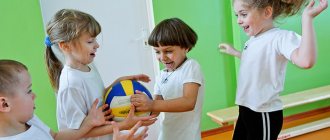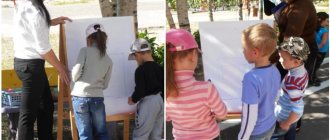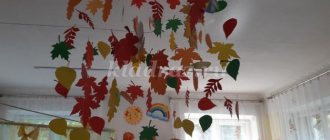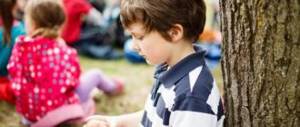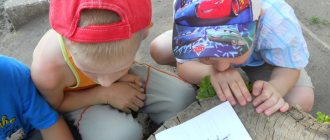outdoor games. interesting facts about physical education (junior group) on the topic
A child can most easily learn to walk correctly, run quickly, boldly jump, deftly climb and throw a ball in an outdoor game, when he unnoticed, without coercion, fulfills your requirements and improves both in motor development and in the ability to behave correctly in a group. Outdoor games for kids are thematic in nature. At first, outdoor games are very simple, their content, concepts and definitions are taken from the children's world: children, animals, simple objects and actions with them. A child will quickly learn to walk correctly following a line drawn on the ground, along a bench or a low fence; play with animals following each other; into soldiers marching in a column; in children crossing a bridge over water; on a train running on rails, etc. When walking in a straight line is mastered, you can add zigzag walking between obstacles (cubes). You should also learn to run fast gradually. First, invite your child to run in short distances (for example, in the park from bench to bench, from tree to tree). Later, the child will run freely on his own, and you make sure that he does not run for too long without a break; after a short rest, the child quickly regains strength and can continue running. Teach him to run between placed objects, run around furniture, people, toys.
Outdoor game Clouds and wind. The child depicts large and small clouds with circular movements of his hands above his head and movements of the whole body. Then he runs quickly - like clouds driven across the sky by the wind. Outdoor game Car. The child imitates the movement of a car (train, bus, plane) by performing the corresponding movements with his hands. Outdoor game Tulle. Play tag squatting, on one leg, “wooden”, “iron”, etc. (children escape from “tag” by squatting, standing on one leg, touching a wooden or iron object). The role of the “tag” is alternately played by an adult and a child, and give the child the joy of tagging you. After a long run, do breathing exercises with intense exhalation. Outdoor game Bees Together with your child, depict bees flocking to a hive, which can be marked with a line on the ground, limited by a clothesline, etc. Make sure that the child runs easily and his arms move freely. Outdoor game Rain Run away with your child to hide at home “under the roof” as soon as possible. Outdoor game Puddles Draw various lines and circles on the ground. Then take your child by the hand and run and jump over the drawn obstacles. The goal is to teach the child not to stop before the line, not to interrupt the run. Outdoor game The doll is jumping. An adult holds the child by both hands, facing him, and together with him jumps from foot to foot or on both legs at the same time. Later, do the exercise without holding hands. Outdoor game Sparrows The child jumps in place on both legs and from a place forward and backward. The adult first holds the child under the arms, and later by the shoulders, facing him. Having mastered this method, hold the child by only one hand and jump with him. Climbing should be actively used in your activities and outdoor games, as it has a beneficial effect on the mobility of the spine, strengthens the muscles of the arms, legs and torso, and stimulates the activity of internal organs. Children love to climb, especially up, because this is how they satisfy their need for movement. Parents should strive to ensure that the child, instead of crawling on his knees, which overly burdens the sensitive knee joints, quickly begins to crawl on all fours, leaning on his hands and feet. Outdoor game The cat is sneaking The child is crawling on all fours. Then he stops and turns his head (the cat looks back), then tilts his head to the ground (the cat drinks). The exercise is performed only on a hygienic mat. Outdoor game Snake crawls An adult strengthens the rope in a horizontal position low above the ground and encourages the child to crawl under it on his stomach. Obstacle course. As already mentioned, you can easily set up an obstacle course at home - from several chairs placed on the floor, a table, an ironing board and a clothesline (it should be secured low above the floor). A child, under the guidance of an adult, overcomes various obstacles, alternately crawling under them, stepping over and climbing them, and jumping onto the carpet (a jump is allowed only from a height at the level of the child’s waist). Outdoors, set up an obstacle course using rope, twigs, boards, logs, bushes, etc. Repeat overcoming the path with your child at least 4 times; in some areas let him climb on his own, in dangerous places carefully help him and belay him to eliminate the possibility of any injury. Play develops independence in a child. Outdoor game Tunnel The child depicts a train that passes through a tunnel made up of overturned chairs, stretched ropes, etc. The child runs and crawls under obstacles without touching them.
Outdoor game Teddy Bear A child climbs (with a safety net) up an inclined ladder, an inclined board, along a bench, etc. At the same time, an adult says: “The bear climbs, climbs from step to step. The bear climbs and climbs, and he climbed high.” A child can easily learn throwing through play. The goal is to teach children to immediately throw correctly - forward and upward, so that later they do not have to wean them from the habit of throwing an object from below or from the side. First, teach your child to throw light objects high enough. To help your child, stretch a rope over his head and ask him to throw a ball over it. Show your child the correct throwing swing several times. Catching a ball from the air is too difficult a task for a child under 3 years of age. Therefore, it is enough that the child learns to throw an object with the correct swing and roll it in a given direction. Outdoor game Pigeon competitions Paper “pigeons” are a great help for practicing forward and upward throws. An adult and a child, competing, throw them at a distance. Outdoor game Skittles This is a great game for training accuracy and skating skills. Plastic skittles, hygienic and cheap, can be one of the first New Year's gifts for a child. Outdoor game Rolling the ball A good preparatory exercise for throwing and catching a ball is also rolling the ball to each other. An adult and a child sit on the ground (legs apart, opposite each other) and roll the ball to each other. Later, you can roll two balls at once (pay attention that the balls do not collide with each other). A child performing this exercise learns to concentrate and develops the ability to catch a rolling ball and accurately direct it to an adult. Exercises using various objects in a special environment. Staying in the fresh air is an urgent need for a young child. Therefore, you should find an activity on the street that he would like and contribute to his all-round development. In modern apartments, the child’s opportunities for play are very limited, so parents should, as often as possible, go with their children to parks, sports grounds, bathhouses, and the forest, trying to ensure that the child spends as long as possible in the fresh air every day at any time. of the year. With the change of seasons, the nature of a child’s motor activity in the open air also changes. However, he must have a constant opportunity to play something, to achieve something, so that being in the air stimulates further motor development and promotes health. the stairs first with a safety net, then on his own, holding on to some support or without it, but always with a side step. The goal is to teach the child to step on each step with the other foot. This is an exercise in balance, on a high ladder - in courage; In addition, it strengthens the abdominal muscles. slides in the city, so you go on them with your children, usually during Sunday walks. On a small hill with a gentle slope, encourage your child to run up the hill and slowly run down into your arms. Since running down a slope increases speed, teach your child to deliberately slow down to avoid falling. In winter, this slope is perfect for practicing sledding - first with your parents, and later (on a safe slope) on your own. The child learns on the slide to properly guide the sled and overcome fear when it moves quickly. Benches, logs, and boards can be used for walking on an inclined plane, climbing on all fours, climbing on and off with a safety net. A swing is a great way to help a child overcome his fear of heights. However, take care of safety: to prevent the child from falling, the board must be well secured in the middle, and both ends must be equipped with handles. A branch bent low above the ground can be climbed and hung on. Hanging on the hands of young children is not recommended; only hanging with support on the legs is allowed (standing on the ground, on a branch located below, etc.). An elastic band, a long rope, a thin rope are suitable projectiles for crawling, stepping over, jumping both from a standstill and from a run. Make sure that children jump onto a soft surface. Sliding down a slope is a great exercise in courage and balance. Make sure your child is safe when completing the descent!
outdoor games for children of primary preschool age.
MAGAZINE Preschooler.RF
Russian folk outdoor games. “The wand is a lifesaver”Senior preschool age.
Goal: To instill interest in Russian folk games.
Teach children to act according to the rules without breaking them.
Cultivate goodwill, endurance, and the will to win.
Progress of the game: Children choose a driver using a counting rhyme:
“I bought myself a pipe and I’ll go outside! Louder, pipe, pipe, we are playing, you drive!
The driver closes his eyes and stands facing the wall, against the wall, next to him is placed a stick made of wood (50-60 cm long, 2-3 cm in diameter) and brightly colored so that it is clearly visible in the green grass. The driver takes the stick, knocks on the wall and says: “The stick came, but didn’t find anyone. Whoever he finds first, he will go for the wand .
After these words, he goes to look. Noticing one of the players, the driver loudly calls him by name and runs to the stick, knocks on the wall, shouts:
“The lifesaver found... (player’s name)!” . This is how the driver finds all the players. The game repeats itself. The first player found when repeating the game must lead. But the player who has been found can run to the stick earlier than the driver with the words: “The wand is a lifesaver, help me out!” and knock on the wall. Then throw it as far as possible against the wall and while the driver is looking for the stick, hide again. The driver again quickly runs for the wand and repeats the actions described above.
Rules of the game: You cannot peep when children are hiding. The driver must count the counting count slowly so that the children have time to hide. The driver should look for players throughout the playing area, and not stand near the stick. Children can run from one hiding place to another while the driver looks for a stick and puts it in place against the wall.
Option:
1. Children can help out a player they have found; one of the players quietly comes out of hiding, quickly runs to the stick and says:
“The lifesaver found... (player’s name)!” - he knocks on the wall with it, then throws the wand as far as possible. While the driver is looking for her, the children are hiding.
2. The driver is chosen using a counting table. All children have a small stick. Children carefully place their sticks on a long stick, which lies on a stump next to the leader. The presenter turns away so as not to see where the players are hiding, and counts to 10. Having counted, the presenter goes to look for the children. Each of the players tries to unnoticedly run to the stick first and hit its end lying on the stump, so that small sticks fly into the air. The driver tries to prevent them from doing this. If someone managed to do this, the driver drives again. If the driver manages to win, then the player found first becomes the driver.
| Next > |

